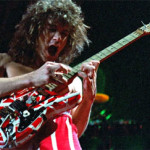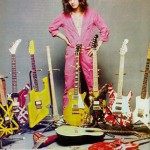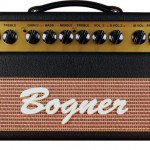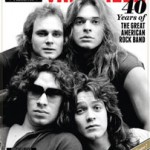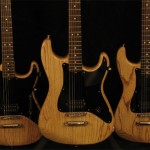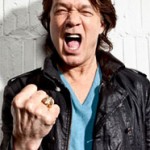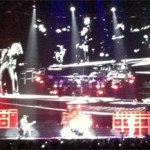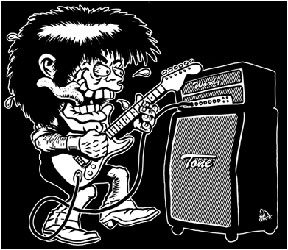The Rest of Steve Morse’s 1978 Gear
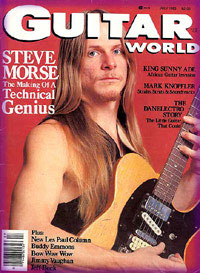 Here’s the rest of Steve Morse’s 1978 gear, from an excellent interview with Jas Obrecht. It’s a much longer interview than what you’ve seen here, worth a full read.
Here’s the rest of Steve Morse’s 1978 gear, from an excellent interview with Jas Obrecht. It’s a much longer interview than what you’ve seen here, worth a full read.
Btw, the interview was not for Guitar World per the pic at left. Just used that cover shot because it’s a great close-up of Steve’s original guitar.
Everything below is Steve talking.
Guitar: Switching
I had to add a switch – in an unlikely place for a regular guitarist. It’s right below the picking line, the strumming line. I have a three-way switch and two toggle switches, so that I can have six combinations…more combinations than I use, but I experimented with them all.
You have the four on – each pickup on. And then I have two double. And the reason I didn’t go through a big, more complex wiring is because the other doublings didn’t sound good. So I just figured I’d just put the ones I needed on.
I had the switches programmed so that there are several presets you can do. Like, one switch cuts everything off except the Strat pickup. So you can be presetting the other switches for the next sound coming up, and then flick this mini-toggle switch, and bam, you’re in the new sound.
[I] put my switch…right by my hand. I saw exactly where I strum, where I pick, and put it a fraction of an inch away. So if I want to, I can just extend my little finger and snatch up the switch without stopping.
Guitar: Frets/Fingerboard
It’s got Gibson frets on it. The Gibson frets stand up more.
Over the years, I would never let anybody plane that fingerboard with each refretting job. It’s sort of scooped out between the frets, and I really like that a lot.
When I put vibrato on, it’s so easy with the scoops and the eroded fingerboard and high frets to just really grab a hold of the string if you want to shake it.
It’s a rosewood neck [board], so you don’t get that slippery feeling that you do when you get sweaty, especially with the new maple neck.
Strings
.010 to .040. In fact, every string – they all sound the same to me. [Laughs.] The biggest difference seems to be when they’re new. I mean, when they’re new, they sound a lot different than when they’re old.
Effects/Board
…typical wah-wah, echo. The phase shifter is a…Roland Boss Chorus Ensemble. It’s nice. It has one speed, and then another effect that you can switch back and forth.
I bypass the actual unit – you know, you just get a two-position, double-threaded switch. The reason I did it was so it wouldn’t go through that unit all the time – which I hate when they do that, because all it does it add hiss and stuff. So everything is bypassed.
So wah-wah, Chorus Ensemble, echo, and a special thing that I use as a volume control – not a master volume from the guitar, but from the preamp out of the main amp to the second amplifier. This control just adds in another amp. You turn down the guitar, add in the other amp, and all of a sudden you’ve got as big a sound as you had before, only it’s clearer.
Also I wired in a stereo plug to my Echoplex, which runs to a volume pedal…so that I can control the echo on and off.
[Interesting here about the wet cab.]
The echo is actually more complicated than that. It has a separate volume control for the echo, and nothing but the echo goes to the second amp. So you get delay only. So you’re playing through these cabinets over here and switch it on, and all of a sudden instead of distorting and jumbling up what you’ve got through the first amp, all it does is turns on the second amp, which is nothing but the delay.
It really fattens up the sound, and it sounds neat, like back in the old days when you used to separate the cabinets. Of course, I ended having to put a volume pedal between the two so that you could preset the volume of the echo and then turn it on or fade in the echo….
[The effects board is] cut out of a piece of plywood. We were making cases – we made our own cases for a while in the real hard days. Our boards fit exactly in these Armond footlockers that I was lucky enough to score….
I made a talk box – everybody made a talk box at some time.
Amps
[Ampeg] V4 100-watt. Well, they say it’s 100-watt – I don’t know what it really is. It’s just an Ampeg tube amp. It’s interesting because it’s got more midrange control than any other rock and roll amp.
That goes to Gauss speakers, 12-inch. And the Acoustic [head] goes to JBL 12-inch. The Acoustic is a 150, just basic rock and roll. It distorts a little bit when I really put it to it, but the way that I use it, it turns out that a clean hi-fi amp isn’t as good, because it gets this buzzy, searing edge on it that I don’t find very pleasant.
I was never able to make any of that Crown concept work for me – yet. That is, you find a great preamp, and then put it through a Crown and all your problems are solved. I couldn’t get it to happens, because I play rhythm and lead guitar, and that is the problem.
_____
The Dixie Dregs live, 1978. Why is Steve this good? Dang!
– End of Part 2 of 2 –
Category: Acoustic amps, Ampeg, Boss/Roland, Echoplex, Gauss speakers, JBL speakers, Steve Morse





